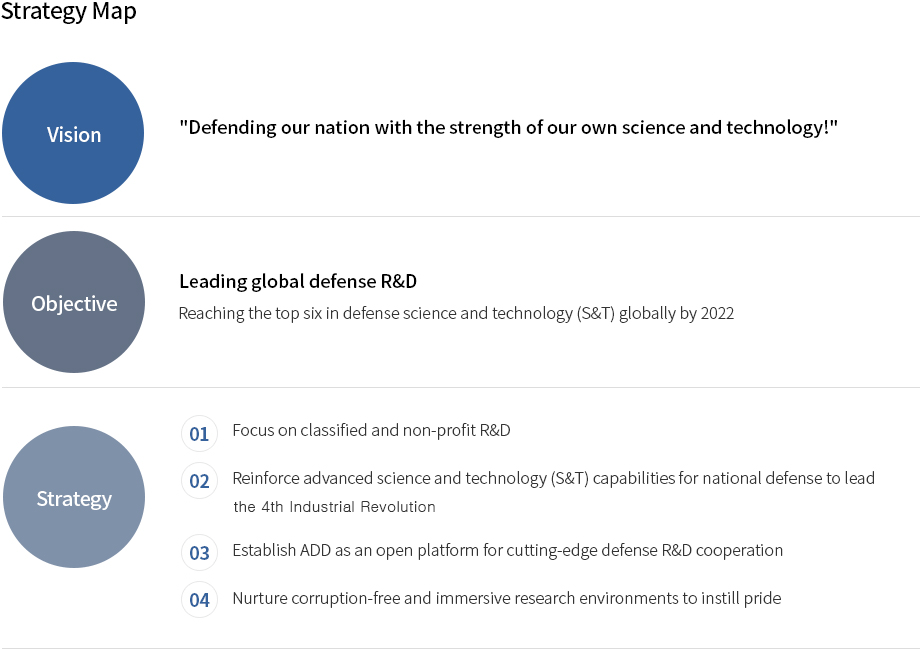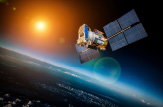Who We Are
Mission & Vision
-
MISSION
"To contribute to the reinforcement of national defense power and the accomplishment in self-reliance of national defense by ... taking charge of the technical survey, research, development, and testing of weapons, equipment, and supplies required for national defense as well as the survey, research, and testing of science and technology related thereto"
(Article 1 of the Act on the Agency for Defense Development) -
DUTIES
"Technical surveys, research, and development of weapons, equipment, and other military supplies, and the survey and research of systems engineering, ergonomics, and other science and technology…"
SEE MORE

Strategy. 01
Focus on classified and non-profit R&D
- Focus on classified and non-profit R&D which are currently overlooked or ignored in the civilian sector, and concentrate R&D capabilities on weapon systems and advanced science and technology (S&T) for national defense through disruptive innovation
- Promote defense industry's development of unclassified weapon systems
- Strengthen defense science and technology (S&T) support as a defense think-tank
- Focus on development of classified weapon systems based on environmental change in national security
- Accelerate R&D and accumulate technologies required to develop classified technologies and the Triad System to counter nuclear/WMD threats
- Contribute to the denuclearization and establishment of a peaceful regime on the Korean peninsula by focusing R&D capabilities on advancing classified technologies which enable long-range force projection
- Promote advancement of cutting-edge defense science and technology (S&T) and acquisition of capabilities which hold high-potential in future applications in order to gain competitive advantages in technology for self-reliant national defense
* Increase advanced defense science and technology (S&T) development budget in fields such as quantum technology, AI, autonomy, and others — from 28% (2020) to 40% (2023)
- Restructure to respond to environmental change in national security and acquire strategic agility
- Achieve organizational restructuring by 2020 to flexibly respond to the environmental change in national security and perform the role as a hub for defense science and technology (S&T) to respond to the needs of the military with agility
Strategy. 02
Reinforce advanced science and technology (S&T) capabilities for national defense to lead the 4th Industrial Revolution
- Establish a solid foundation via advancements in cutting-edge defense S&T which lead the way in an era represented by the 4th Industrial Revolution and the 3rd Offset Strategy
|Advanced Defense Science Core Areas (Future-oriented S&T Driven by Challenge and Discovery)|
| Area | Main Technology | ||
|---|---|---|---|
| Space/Physics/ Chemistry/ Biology | Space Technology | Space technologies for military reconnaissance satellite constellations, military satellite communication, and micro/nano satellite |  Original Technology in Space & Physics Original Technology in Space & Physics |
| Sensor Technology | Advanced radar (Active Electronically Scanned Array Radar, Over-The-Horizon Radar, Photonic Radar), advanced navigation system, high-performance seeker, and underwater acoustic sensor technologies | ||
| Laser Technology | High-energy laser weapon technologies | ||
| Quantum Technology | Quantum radar technologies | ||
| Physics/Chemistry | High-energy/high-efficiency material, high-performance warhead (original technology), new material, and chemical/ biological/radiological defense technologies | ||
| Biology | Synthetic biology technologies | ||
| Smart Technology/ Software | AI Technology | Core technologies applicable to weapon systems utilizing artificial intelligence and big data |  Smart Technology / Software Smart Technology / Software |
| Autonomous Technology for Unmanned Systems | Core technologies including autonomous driving — essential to unmanned systems (UGV, USV, UAV, etc.) — and swarming control | ||
| High Capacity Wireless Communication Technology | 5th generation network and terahertz technologies | ||
| Cyber Technology | Core technologies for cyber-attack/defense | ||
| New Concept Design | Future Platform Design | Design technologies for developing advanced platforms including stealth unmanned aerial vehicles/unmanned combat aerial vehicles, special vessels, and launch platforms to innovate the future battlespace |  New Concept Design New Concept Design |
| New Concept Technology | New-concept weapon design technologies such as boost-phase interceptors, long-range air-to-air missiles, and anti-submarine ballistic missiles | ||
Strategy. 03
Establish ADD as an open platform for cutting-edge defense R&D cooperation
- Utilize R&D capabilities of government funded R&D institutes under the Ministry of Science and ICT
- Establish a technology cooperation committee among R&D institutes and interchange manpower
- Expand application of technologies developed by government-funded R&D institutes to the defense area and enhance basic research
- Foster defense industry technology development and support defense exports
- Provide expanded access to ADD test facilities/devices and support industry-led R&D
- Hold DID (Defense Industry Day) to provide technological support and to encourage effective communication among major defense companies and SMEs
- Design and develop new weapon systems with high cost-effectiveness to strengthen export competitiveness
- Strengthen expertise of manpower (government/military/defense industry) and expand professional training courses related to 'export support' at the Defense Science and Technology Academy
- Establish a global research environment through strengthening international cooperation
- Promote to enact a guideline for expanding international joint R&D projects
- Expand international technology cooperation with advanced defense science research institutes
- Promote tailored international cooperation with each countries' defense science R&D institutes and strengthen research cooperation with the US in advanced core technologies such as AI and unmanned autonomy
- Provide specialized advice (Defense Think-tank)
- Conduct technical analysis and evaluation of hostile weapons such as North Korean WMD and missiles, etc.
- Provide technical support to non-proliferation regimes such as MTCR, WA, and OPCW as technology experts
- Benchmark DARPA*, DIU** and SCO*** in expanding the Advanced Defense Technology Research Institute, Institute of Civil-Military Technology Cooperation, and Concept Research Center respectively
- * DARPA : Defense Advanced Research Projects Agency
- ** DIU : Defense Innovation Unit
- *** SCO : Strategic Capabilities Office
Strategy. 04
Nurture corruption-free and immersive research environments to instill pride
- Ensure a corruption-free research environment
- Achieve the highest anti-corruption standard by establishing Fair Trade Commission level [Employee's Code of Conduct] and [Ethics Audit System]
- Enhance transparency and credibility of R&D through the improvement of proposal evaluation procedure, etc.
- Expand the [Employment Restriction Policy] to be applied to Senior Principal Researchers, mandating property registration and preventing individuals to work in the defense industry for three years after retirement
- Recruit and train a dedicated workforce
- Recruit PhD-level experts (over 90% of total recruits) and construct a basis for multi-disciplinary research through balanced recruiting across various fields of science and engineering
- Increase expertise for each individual through domestic/international exchange programs and re-education of senior level researchers
- Convert non-regular employees to permanent employees and/or permanent contractors to comply with the government policy
* As of August 1, 2018: Non-Regular Employees > Permanent Employees (285); Temporary Contractors > Permanent Contractors (89)
- Train Science & Engineering Officers: Benchmarking the Talpiot Program of Israel, the Science & Engineering Officer Program aims to train elite science and technology (S&T) experts at the national level by providing them an opportunity to concentrate on defense R&D without discontinuities in their careers
- Train Cyber Technology Research Officers: The Cyber Technology Research Officer Program aims to train cybersecurity experts at the national level to prepare for future cyber warfare
* In 2018, the program was awarded the Best Human Resource Development Program by the Ministry of Education and the Ministry of
Personnel Management (1st place among 49 public sector organizations)* In 2018, ADD received Level 2 in anti-corruption assessment, the highest level achieved by a public sector organization
* In 2019, ADD received the Presidential Award in the National Quality Innovation Award's Human Resource Development category at the 45th National Quality Management Convention
- Establish an immersive research environment
- Cultivate research culture in which expertise and autonomy are encouraged
- Introduce Smart-working System
- Modernize research infrastructure and establish basis for open R&D
- Enhance and foster ADD "Detail Management" core values — Absolute Integrity, Absolute Safety, Absolute Security, and Absolute Quality

